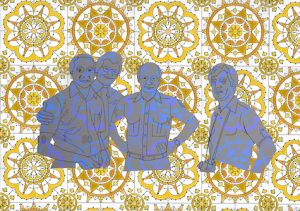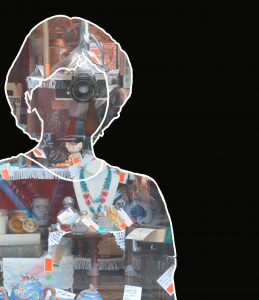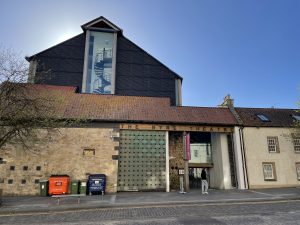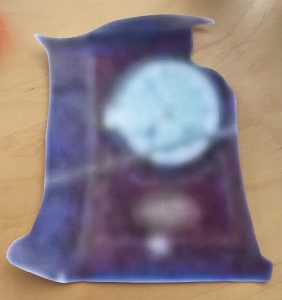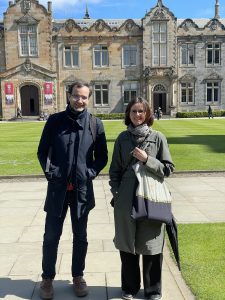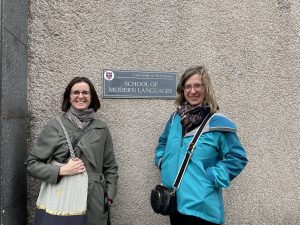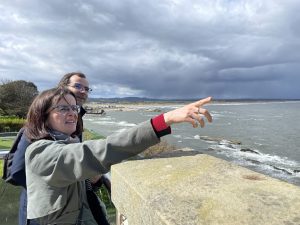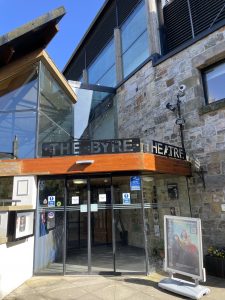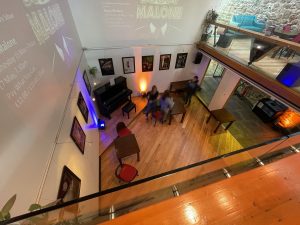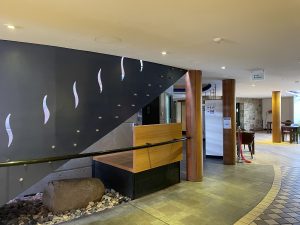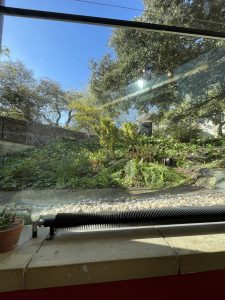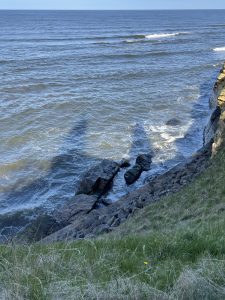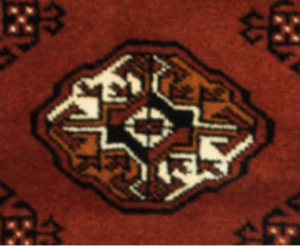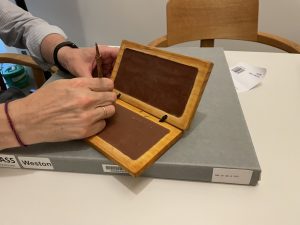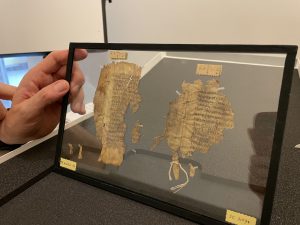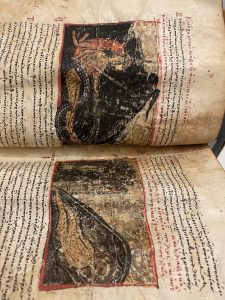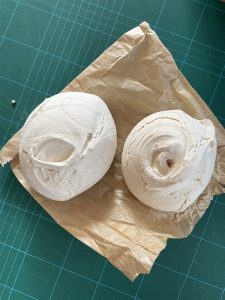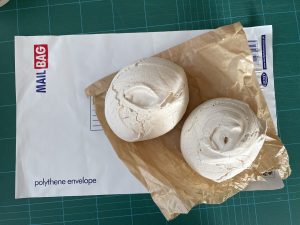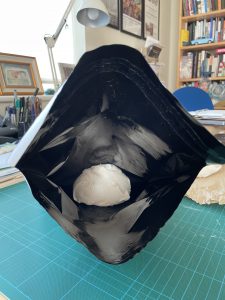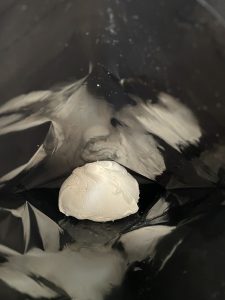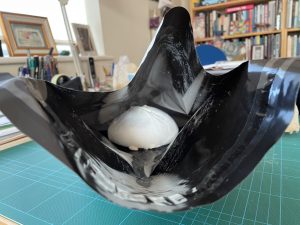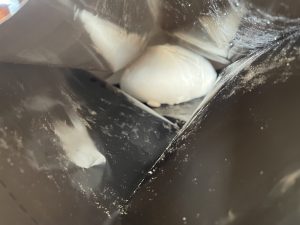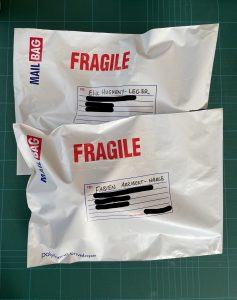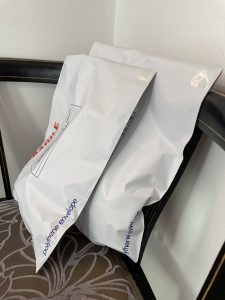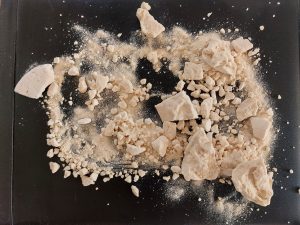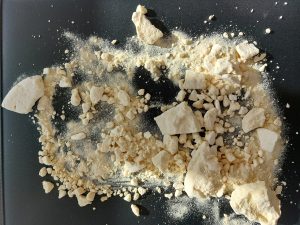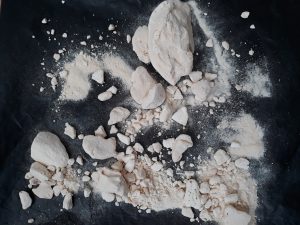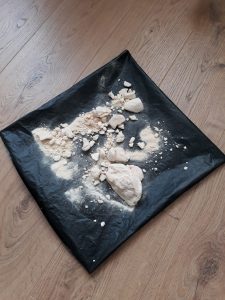Some notes 4am Saturday 27 April 2024
Since I wrote these notes on Saturday morning, everything has moved on a lot further
Returned from research trip to St Andrews yesterday afternoon.
Ideas going through my head right now.
Stream Of Consciousness SOC
Le SOCle – plinth, base, pedestal
Sock
SOC(k)
Could rope off the small desk area on LG where there is wall space to create a free-standing space
Rug, what is rug in French? Tapis? Tapiès. Could do footprints in memory of Ana Mendieta, wasn’t she murdered by Carl André? Whatever happened to that? Read more about that case.
I like the word ‘rug’, it’s so short and ‘ug’ like.
Let my love of puns roam free.
Free-standing, as opposed to being charged for standing.
Can buy AE books second hand for as cheap as can get them, or, invite conference delegates to donate one each and then see what we get, so a random selection, doesn’t matter if they’re annotated, in fact, if they are, so much the better. And ask the local bookshop to provide some in exchange for publicity.
How my mind races, I’ve now got a whole space to imbue with A E
I was reading about the letter Ash on the train yesterday, it looks like A and E joined together. A and E, Annie Ernaux, Accident and Emergency. AutoEthnography. It is one of the ten obsolete letters of the alphabet.
Æ æ
Ash, H in French, aitch, or the now frequent English Haitch ‘ate?
language continually evolving and changing
you can’t hold onto it, it runs away
I like what Jesse Darling says here (https://www.the-berliner.com/art/jesse-darling-interview-turner-prize-winner-berlin-british/) about being freer with the German language, about not being restricted to it being how it’s supposed to be. I am a real stickler for grammar and knowing how the ‘bare bones’ of a language work, which I believe gives you much more freedom to use the language because it gives you an understanding of how it works. Our English teacher at school, Miss B, who taught us so much about the English language, which gave me such an advantage when it came to languages. I don’t know that I have ever played fast and loose with the German language, though I am always doing it on my own.
Playing fast and loose.
Fast and loose – Is that a piece of music, a tune?
Let language split open, go into that.
Or rather let it all fall out
Art and puns. Art and mad language. The Surrealists were into all that. Art and Language. Art and languages
Don’t worry too much about that, do it my way.
Frank Sinatra
Sintra – a municipality in Portugal, just googled it, there’s a mad yellow and red painted castle there it seems (called Pena, Spanish for ‘pain’) and a site entitled ‘How long do you need in Sintra?’*
How long do you need in a place? In a world? In life? How long does anyone really need to live their life? If you could have a particular length of life, how long would it be? If you could have unlimited time? Would you like to live forever if you could? People usually say “If I could keep my health”. Then they start getting preoccupied with holding onto their youth. As if you have to look beautiful forever. Who gives a stuff what you look like if you’re having a good time?
*Neuschwanstein, I’ve got a book about Ludwig somewhere. Chitty Chitty Bang Bang. My old friend CB was from Füssen. I looked him up on the journey to St A, he’s still around, being an artist, living and working in Hamburg still. Must contact him. Downloaded a pic of him to my phone. He looks just the same, just a dusting of icing sugar around the edges of his face.
I hate this fashion for cosmetically interfered with lips which look like rubber.
Do people who’ve had ‘designer vaginas’ get their labia inflated? Pumped up with liquid fat from other parts of their bodies they’d like less big? And if so, can they sit down comfortably? Remember Annette Messager’s work, whatever happened to her? What is she doing/making now? Just looked her up. I never realised she had been married to Christian Boltanski. She’s 80 now. https://www.mariangoodman.com/viewing-room/annette-messager-frieze-ny-2021/
This needs saying again:
Who gives a stuff what you look like if you’re having a good time?
Giving a stuff.
‘Turgid’ when used to describe language is the opposite of AE’s writing.
There’s a madness inside me dying to get out. They were scared of it when I was at art school and they taught me how to contain them / that / him? And I fell for it.
I fell for it.
I fell for him.
Oh falling falling falling, it’s always about falling.
Falling in love again,
Never wanted to
What am I to do
I can’t help it
I used to sing this in an exaggerated Dietrich way. I haven’t done so for a long time.
Revive this and record it and have it available on the QR
Q [uee] R code
uee
oooh eee
Choose piano music to go on the piano. I should have spoken to that student who was playing the piano. I didn’t talk to any of them, though I did imagine doing so and had imaginary conversations with them in my head. Imagined conversations are so much better, you can get the replies you want. I didn’t ask any of the students how they felt about the place, though I got a sense of how that was. There was a quiet and studious yet relaxed feeling about the place when I was in there. It seemed well liked. I could feel that. Some students working on their own, some in small groups discussing their studies. A nice group of about four or five of them at the sofas on the mezzanine at the garden side, having a chat but quietly, not hushed, just respectful of others. No one making a loud noise or laughing out loud or general huge hubbub going on. Don’t get me wrong, I’ve nothing against loud laughing, in fact, I once made a piece of work about it where I put a loud laugh in a safe with very thick walls and locked the door and the laugh spilled out. It was something about the fear of the ‘laugh of the medusa’ but on the other hand, if you’re wanting to get on with work you don’t really want a loud racket.
A loud racket – a loud (tennis) racket?
These are some pretty stream of consciousness notes, of which there is going to be quite a lot in the days that follow my trip, I think. Deciding I will risk putting these on the blog, unedited, the flow of ideas, how I am consumed by, possessed by the working out of the works and the exhibition. How it is constant work, how even in my sleep I am at it.
Oh, reminds me of a dream I just had before I got up of a beautiful double rainbow happening in a room, adjacent to the one I was in. In this adjacent room it was raining. By the time I got in there most of the rainbow had gone.
My trip – psychedelics. Ask K more about this. She is a consultant doctor friend whose specialism is pain, very knowledgeable and clever and very much into holistic approaches and frustrated by conventional medicine’s chopping up of the person into symptomatic parts for removal.
‘pain’, a faux ami, bread in French
holistic, holi-stick, holy stick
doctors as ‘removal men’ (and women, of course)
false friends, those friends who won’t let you be who you want to be and try to hold you back by bullying you if you show that you’re clever, girls, not wanting to be shown up for not trying by a girl who tries.
A trying girl. ‘She can be very trying at times’. Overheard conversations like the oh-so-significant one where AE hears her mother talking to a friend about her dead sister.
The books on the shelves could be in addition to Annie Ernaux’s. I could make a selection there – include Atwood’s Cat’s Eye, which I must reread.
I was going to do so much reading on the train but I just kept looking out of the window trying to capture the evanescent view. Or looking at my phone, communicating all the way with friends, silly stuff, sending them lists of all the snacks I had in my bag.
This trip, preoccupied when it came to the journey with planning the snacks I would take. Having provisions. A preoccupation inherited from war-time, when there wasn’t enough. Passed on by Granny and Mum. A safety net. Could have a snack stash in the exhibition. Vermin risk.
AE imbuing the place, a three dimensional palimpsest. I think what happens from now on in is going to be . . . it is all falling into place.
Falling into place. – yes, nothing can be suspended in case it falls on people’s heads. Even something light as a feather, which would give them a mild surprise if anything. Imagine a feather falling on your head, and how you would react. Would it require a trip to A and E? A video: a feather falling on your head and a completely over the top reaction, “ow!” or “ouch!” Blood perhaps? a bandage?
I can make a series of these video works viewable by QR code and put the QR code up somewhere. There are ample opportunities for putting things up, find the right space.
‘Vainglorious’ – that piece, could be remade as vinyl. Put up where it will cast a shadow.
How do you write the letter ‘ash’ on a keyboard? Practice it in a notebook. Find out all about it. Simples, hold down the a key then press 5
Routes you go down.
Free-standing piece, exercise books.
Books you exercise with. Weighted books. A heavy read. Difficult to pick up.
Dating: guys who are difficult to pick up. Have a really heavy man, it’s difficult to pick up. Put him out in the garden. Maybe stuff him with something which would get heavier when it rains. Make all this stuff.
Do these objects work physically or are they better as word-play, as ideas?
Golf. Ask M about golf.
Where my brain goes. Unfiltered.
Filtered coffee.
Not having to put it through the filter of trying to make it look beautiful, or ambiguous or like art. Perec, doesn’t AE like Perec? Les Choses. Read more Perec? Do I enjoy him or does he just get in the way of my own idea of fun, with his idea of fun? Do I enjoy a fun read? And Autobiographie des objets – Francois Bon
Can anyone else get anything out of your stream of consciousness thoughts? Does it matter?
Stream of consciousness. Could make that in the garden, with sparkly streamers, have it running down the slope, glinting in the sun. Put some in our garden here and see how it behaves? Need a slope which catches the rain. The idea of fashioning some ‘sculptures’ out of clay to place in the garden. They are about me ‘performing the artist’. I like examining that. In which ways do I still ‘perform the artist’? Kevin Atherton, he made performance works about that. I used to be Facebook friends with him, I could get in touch with him.
Getting in touch with people. Reaching out a finger-tip, like ET, to connect with people, like Michelangelo’s painting of the fingertip of god, Oh god, I ought to know what it’s called. Not Vitruvian man, the other one, the Sistine chapel one.
A stream of consciousness art history. Record it, like when people are asked to draw a map of the world and they make up where countries are and it’s funny.
FUNNY
HUMOUR
COMEDY
DON’T HIDE YOUR FUNNY BONES
Why would you?
Funny bones.
Amusing bones.
This is an interesting train of thought
Train of thought
This is an interesting train of thought I’ve been having all along: where is the humour in AE? There isn’t a whole lot and yet I love reading her. How and where I feel different from her and how and where we connect.
A love piece, a being-in-love-with her piece. Where I just let rip with my ‘relationship’ with her, with my imagined relationship with her. There is so much fantastic SEX in her works. She loves sex. Sex is celebrated. The young folk call it ‘sex positivity’ these days, don’t they. I find that sad. They have to distinguish when they are talking about sex as something good, because so much of the discussion is about abuse and ‘me too’ and sexual violence. How sad. Women’s love of women. Being alongside her in her sexual adventures. Distinction between sex and desire. Is it AE’s desire which comes across so strongly?
Will there be a catalogue to my show? Yes, I will make one.
All these little interventions, placed there. Here there and everywhere, like the Beatles song. Letting go of it having to be art or to be ‘like art’.
Elise and Fabien as muses. Companions. Collaborators. The journey is not lonely and solitary and hard and boring. It is fun and companionable and warm and sociable. The sun shines. If I can’t put the curtain up I’ll put it up elsewhere, against a beautiful blue sky and film it dancing in the breeze. Rose Finn-Kelcey’s flags ‘Power To The People’. Ah, Rose. Motor Neurone Disease took her. Such a closing down for such an opening up flower of a person.
Heartbreak at the heart of it all.
About everything.
Ha ha
Ha
Tour de France, Kraftwerk.
Breath.
Last gasp.
H
French for ‘aitch’ is ‘ash’
‘ash’ is the name for the obsolete vowel æ
Golf: putting balls into holes. The breasty golf-hole door flaps at the back entrance, or is that the front entrance? Turn that into a handy breasty golfy game. What are they and where do they go? Do something with them. Defo.
The architects like to make buildings where you don’t know which is the front and which is the back. Look up the architects. Sound like my kind of pranksters.
Marcel Broodthaers’ ‘Pense-Bête’ (‘Reminder’) made in 1964 same age as me and same number of years since AE’s abortion
hommage à
femmage after Miriam Schapiro. (https://madmuseum.org/views/unapologetic-feminine-excess)
dommage. – meaning ‘shame’, it’s a shame, what is the difference between la honte and le dommage? ask E and F?
c’est dommage
dammage
damage
damagée
dame-âgée
tbc
